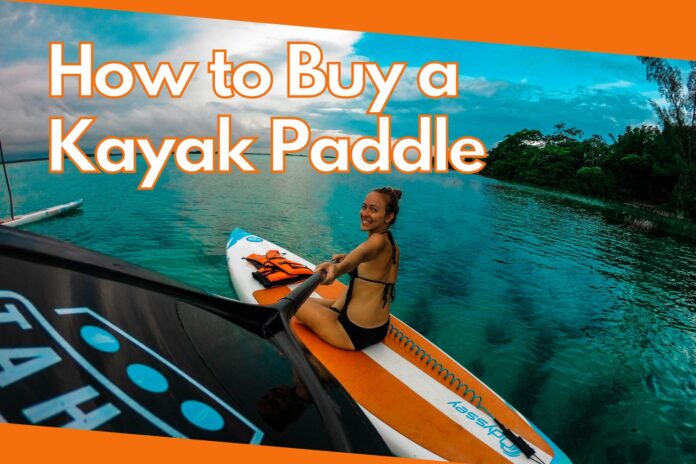A kayak paddle is just a paddle, right?
No, not really.
Just like with all bits of kit for our sport, a lot of clever people spend a lot of time designing what they hope will be an ideal paddle for a very specific purpose.
We have been at the stage for a long time where you most probably wouldn’t choose to use the paddle you take on whitewater on a touring trip, and you certainly wouldn’t do so the other way round.
This article is designed to help you know exactly what to look for in a paddle – whether it’s for whitewater kayaking or kayak touring use – when you go out to buy one for yourself!
Whitewater Vs Touring Paddles
There are a few fundamental differences that make a kayak paddle suitable either for whitewater kayaking or for kayak touring. The most obvious are blade shape and shaft length.
Whitewater paddling is aggressive, and requires ‘high-angle’ strokes, where each time you plant the paddle at as steep an angle as possible, engaging maximum trunk rotation and body movement.
An ideal stroke is almost a ‘scoop’ with the shaft angled as close to vertical as possible. This gives you maximum power, allowing for quick acceleration and maintained speed through holes.
The best sort of paddle for this aggressive style is one with an asymmetric blade that has plenty of surface area without being too long.
You need to be able to switch from one side to the other quickly in order to maintain a high stroke rate, so ideally whitewater paddles shouldn’t be too long, between 190cm and 203cm is the norm.
Kayak touring paddles, on the other hand, are generally longer (usually between the 210cm and 240cm mark), and have much longer, narrower blades generally suited to a more relaxed and maintainable ‘low-angle’ style of paddling perfect for long periods of time spent paddling your kayak at as steady pace.
Obviously, these are general lengths, and choosing the right length for you is an important consideration to make when buying a paddle (see ‘Sizing Your Paddle’ box).
Often a manufacturer will make a model of paddle in a selection of standard lengths, and will sometimes offer a bespoke custom-build option, which will allow you to choose length, materials and feather (see ‘Feather’ box).
Feather
The feather of a paddle is the angle at which the broad side of the blades is offset from being parallel with the length of the shaft.
A feather of 0 degrees means that the blades are completely parallel, whereas a feather of 90 degrees means that one blade is rotated 45 degrees clockwise – and the other the same amount anticlockwise – of the shaft meaning they are at right angles to one another; as well as, incidentally, interchangeable between left and right handed provided the blades are symmetrical.
Once again, choosing the correct feather for you is a matter of preference, although with two piece split paddles – most commonly these are of the touring variety – you can often adjust the feather.
The feather of your kayak paddle determines how much you have to cock your wrist for each stroke, and should compliment your trunk rotation to give you excellent control.
For whitewater paddling, which requires you to be dynamic and rotate a lot, the standard feather is around 45 degrees, but sometimes even as low as 30, depending on preference; although touring feathers are not radically different.
Experiment, and work out what’s most comfortable for you!
Cranked shafts are an excellent way of combating sore wrists caused by paddling: the kinks where you put your hands greatly reduce the action in your wrist as you paddle.
Almost invariably a pair of ‘cranks’ will set you back more than a straight shafted paddle – and this goes for touring and whitewater – but the many people who have made the leap from straight shafts to more wrist-friendly cranks will swear to it being worth the extra expense.
Sizing Your Paddle
Taking that whitewater and touring paddles are different lengths as a given, there are a few considerations to take into account when sizing your paddle.
The biggest deciding factor is your height.
As a general rule of thumb, taller people will be most comfortable and be more likely to develop good technique with a longer paddle, and vice versa with shorter people and shorter paddles.
Then there are other considerations, like discipline.
A freestyle paddler might favour a shorter paddler than a whitewater paddler who likes running rivers.
Style also, if you’re a predominantly whitewater paddler choosing a touring paddle, then you’re likely to import your more aggressive and dynamic paddling style into your touring, so may find it less of a shock to the system if you opt for a shorter, more ‘high angle’ paddle.
If you have a particularly wide or long kayak, you may find it is more unwieldy in the water if your paddle is too short.
Things like individuals’ specific proportions make a difference too, so the following is merely a rough guide – we strongly recommend you trying out a kayak paddle of a particular length before buying.
Whitewater Kayaking Paddle Size Guide
| Paddler Height: | Ideal Paddle Length: |
|---|---|
| Up to 160cm | 188cm – 194cm |
| Up to 170cm | 191cm – 197cm |
| Over 170cm | 194cm – 203cm |
Touring Kayak Paddle Size Guide
If you favour a more aggressive, ‘high angle’ style of paddling more like that used by whitewater paddlers, then deduct about 10cm -20cm from the suggested length ranges.
If you have a particularly wide boat (more than 55cm at the widest point) then err on the side of a longer paddle.
| Paddler Height: | Ideal Paddle Length: |
|---|---|
| Up to 160cm | 210cm – 220cm |
| Up to 170cm | 215cm – 230cm |
| Over 170cm | 220cm – 240cm |
Just a quick word on shaft diameters, they do vary.
Also, it does make a difference.
Be intuitive when choosing.
You want a shaft on which you can make a secure hold without having to grip too hard, so naturally a larger hand will require a slightly thicker shaft diameter.
Blade Shapes & Sizes
Almost all blades on high-end and specialised paddles are asymmetric.
They simply work better, allowing a smooth transition into the water and ensuring as much of the blade’s face is working for you when the paddle is planted in the water at the angle that suits you and your style of paddling.
Asymmetric blades also have a concave (drive) and convex (non-drive) face, which ‘scoops’ the water with each stroke affording you maximum efficiency.
The only real advantage of symmetrical blades is that they can be used either way up, so therefore by left or right handed kayak paddlers.
The size of blade is, once again, largely a matter of preference.
The principle underpinning the decision about whether to opt for a larger or smaller blade size is the same with whitewater and touring paddles, although the specific consideration is different.
The larger the blade, the more resistance there is to your stroke.
If you’re a big, beefy touring paddler who’s no stranger to the gym, then a large blade size will be a huge advantage, allowing you to cover distance very efficiently.
If you’re less well-endowed in the brute strength department, a smaller blade is always a trade-off between efficiency and becoming tired and achy too quickly.
You might have more fun if you make that trade.
For whitewater kayakers, however strong you are, a larger blade is going to decrease your stroke rate.
Granted you’ll have plenty of power for punching those holes and what have you; but you have to decide how much control and finesse you want to sacrifice for that power, and maybe consider opting for something smaller.
Construction & Materials
There is a lot of jargon surrounding materials and construction of paddles, although it isn’t difficult to get an idea of which material is the highest performing and offers the best lightweight to durability ratio.
All you need to do is look at some prices and specs of varying models and you get a fairly good idea.
For those of you who haven’t already done this, and didn’t just know anyway, below is a rough guide to paddle materials.
Carbon
Lightweight and durable, carbon is the most desirable material for a performance whitewater or touring paddle, and naturally the most expensive.
Fibreglass
A good second, and much more affordable.
Often even if the shaft is carbon, you will find that blades are made of this.
Still strong, and not overly heavy, fibreglass makes for a good paddle and if you search around you’ll find you don’t necessarily have to pay too much.
Thermo-moulded Foam
This material is growing in popularity as something from which to construct blades.
It has the advantage of being very lightweight, but also very strong.
Plastic
Cheap kayak paddles often come with plastic blades.
Cheapness is the advantage in this occasion.
It is not an ideal material, particularly for a whitewater blade, although sometimes plastic blades prove surprisingly durable.
Not necessarily to be ruled out as a budget option.
Wrapping Up
There you have it, the comprehensive guide to buying the right kayak paddle for you.
Keep the above in mind, and get out there to try multiple paddle options before committing to one for all of your future adventures.
Also, be sure to check our our kayak and canoe gear reviews for some recommendations on which products our testing team like and suggest to paddlers.




